蟑螂历来被认为是地球上适应能力最强的物种,然而水熊虫这种八条腿微型兽实际上比蟑螂要坚强得多,不管天崩地裂,还会继续存在约100亿年。现在,美国军方希望这些被称为缓步动物的微型兽能教会我们真正的坚强。
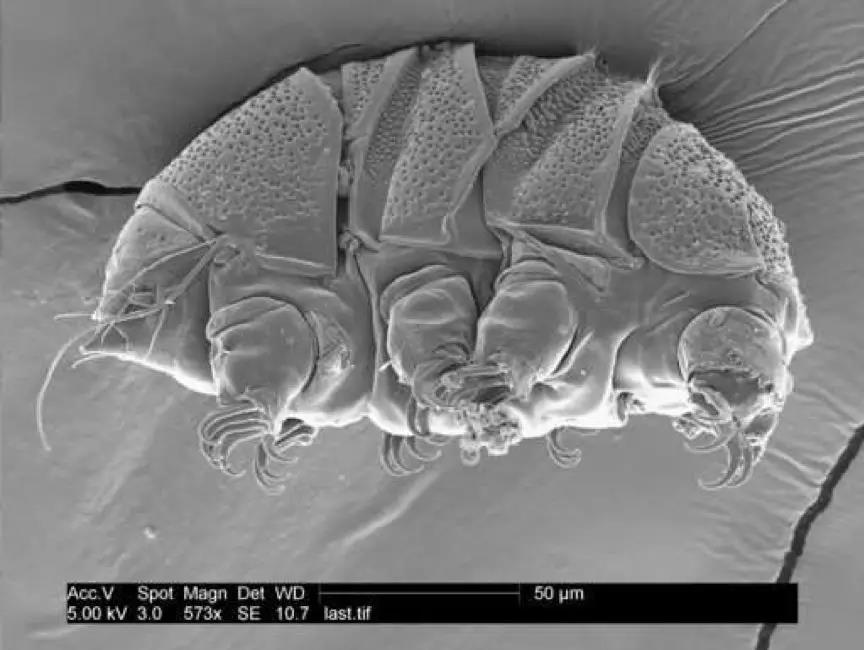
This undated electron microscope image provided by William Miller of Baker University in March 2019 shows a tardigrade of the class Heterotardigrada, also known as a "water bear." The small animals, about the size of a period, are able to survive extreme heat, cold, radiation and even the vacuum of space. (William Miller via AP)
这张日期未定的电子显微镜图像由贝克大学的威廉·米勒于2019年3月提供,显示了一种缓步动物,也被称为“水熊”。这种小动物体型极小,能够在极热、极冷、辐射甚至真空中生存。(美联社威廉·米勒报道)
Earth's ultimate survivors can weather extreme heat, cold, radiation and even the vacuum of space. Now the U.S. military hopes these tiny critters called tardigrades can teach us about true toughness.
地球上的终极幸存者能够经受极端的高温、寒冷、辐射,甚至是真空。现在,美国军方希望这些被称为缓步动物的微型兽能教会我们真正的坚强。
These animals are pipsqueaks, only about the size of a period. Under a microscope they look like some combination of chubby bear and single-eyed alien. And they are the closest life gets to indestructible.
这些动物是pipsqueaks,体型极小。在显微镜下,它们看起来像是胖乎乎的熊和独眼外星人的结合体。而且它们是最顽强的生命。
No water? No worries. Tardigrades survive. Antarctic cold, 300-degree heat (150 degrees Celsius), a lack of oxygen, even punishing radiation doesn't stop these animals. They are so resilient in the face of so many dangers that scientists think their unique biology may hold clues to how we can make crops more resistant to drought, better preserve blood and medicines, and even make more effective sunscreen.
没有水?别担心。 缓步动物可以存活下来。南极的寒冷,300度的高温(150摄氏度),缺氧,甚至致命的辐射都不能阻止这些动物。面对如此多的危险,它们是如此的坚强,以至于科学家们认为,它们独特的生物学特性可能为我们提供线索,帮助我们提高作物的抗干旱能力,更好地保存血液和药物,甚至制造更有效的防晒霜。
When the going gets tough for tardigrades, they curl up, dry out and wait. Then, when the environment gets better and they get water, they spring back to life.
当环境恶化时,它们会蜷缩起来,自动脱水并静静地蛰伏。然后,当环境变好,它们遇到水时,就会恢复生机。
Scientists say they can stay dormant for decades before reanimating.
科学家们说,它们可以休眠几十年,然后恢复活力。
In 2007, scientists put two species of tardigrades in containers, launched them into orbit and opened them up to cold, airless space full of punishing radiation from the sun and stars.
在2007年,科学们将两种缓步动物,放入太空舱,送入了太空轨道,将其暴露在低温、真空及太阳和恒星的强烈辐射下。
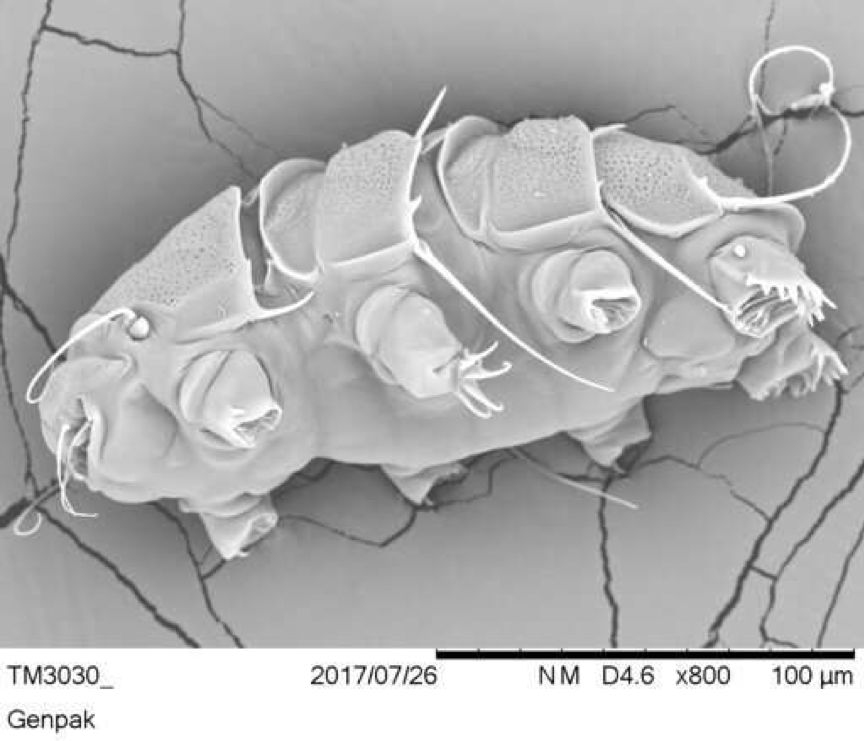
This undated electron microscope image provided by William Miller of Baker University in March 2019 shows a tardigrade of the class Heterotardigrada, also known as a "water bear." The small animals, about the size of a period, are able to survive extreme heat, cold, radiation and even the vacuum of space. (William Miller via AP)
这张日期未定的电子显微镜图像由贝克大学的威廉·米勒于2019年3月提供,显示了一种缓步动物,也被称为“水熊”。这种小动物体型极小,能够在极热、极冷、辐射甚至真空中生存。(美联社威廉·米勒报道)
"If you were put into that same thing, you would explode," said tardigrade expert Randy Miller, a biologist at Baker University in Kansas. They lived and later multiplied, and the offspring from those tardigrade astronauts are still alive, Miller said.
堪萨斯州贝克大学的生物学家兰迪米勒说:“你被扔进相同的环境里,你会爆炸。”米勒说,它们活了下来并繁衍生息,它们的后代依然活着。
There are as many as 1,200 species of tardigrades, and they live all over Earth, from mountain tops to ocean depths to driveways. Not all have the ability to go dormant and come back to life.
世界上有多达1200种缓步动物,无论是高山山脉,还是深海地带,都能找到它们的身影。它们并非都有休眠然后复活的能力。
Speaking from McMurdo Station in Antarctica, Brigham Young University biologist Byron Adams said he can walk a few hundred yards outside and find tardigrades. He called them the tigers of inland Antarctica, near the top of the limited food chain, eating algae and aquatic plants.
杨百翰大学的生物学家拜伦·亚当斯在南极洲麦克默多站说,他在外面走几百码就能找到缓步动物。他称它们为南极洲内陆的老虎,位于有限食物链的顶端,以藻类和水生植物为食。
Miller said tardigrades seem to be the first animals on Earth to have evolved legs, and, sure enough, they look like a first draft: The rear two legs face backward while the front six face forward.
米勒说,缓步动物似乎是地球上最早进化出腿的动物,而且毫无疑问,它们看起来就像草图: 后两条腿面向后,前六条面向前。
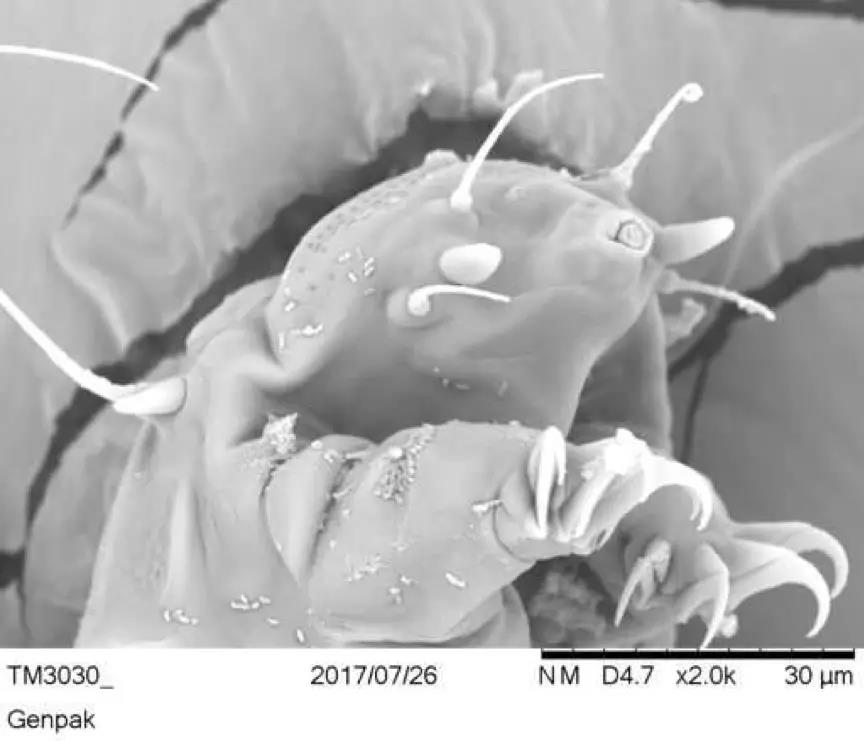
This undated electron microscope image provided by William Miller of Baker University in March 2019 shows a tardigrade of the class Heterotardigrada, also known as a "water bear." The small animals, about the size of a period, are able to survive extreme heat, cold, radiation and even the vacuum of space. (William Miller via AP)
这张日期未定的电子显微镜图像由贝克大学的威廉·米勒于2019年3月提供,显示了一种缓步动物,也被称为“水熊”。这种小动物体型极小,能够在极热、极冷、辐射甚至真空中生存。(美联社威廉·米勒报道)
If they are hurt when they are in an active phase and can't go into survival mode, they die like other creatures. But they don't have a circulatory system or a skeleton, so that allows them to curl up in a hyper-survival mode called "cryptobiosis."
如果它们在活跃阶段受到伤害,无法进入生存模式,它们会像其他生物一样死去。但它们没有循环系统或骨骼,这使得它们能够进入一种叫做“隐生”的超生存模式中。
Not all the critters come back from suspended animation, Miller said. But overall, they survive, even living through Earth's five mass extinctions.
米勒说,并不是所有的动物都能从假死状态中苏醒过来。但总的来说,它们存活了下来,甚至经历了地球上的五次大灭绝。
University of North Carolina biologist Thomas Boothby wanted to know how they manage to survive in "environments we think of as being impossible to live in." So he isolated the genes that activate when tardigrades need to go into cryptobiosis.
北卡罗来纳大学的生物学家托马斯·布斯比想知道它们是如何在“我们认为不可能生存的环境中”生存下来的。因此,他分离出了当缓步动物需要进入隐生期时激活的基因。
Boothby engineered those genes into yeast and says their tolerance to drought increased 100-fold. He hopes the genes could also help crops better survive drought.
布斯比将这些基因改造成酵母,并表示它们对耐干旱性增加了100倍。他希望这些基因也能帮助作物更好地抵御干旱。
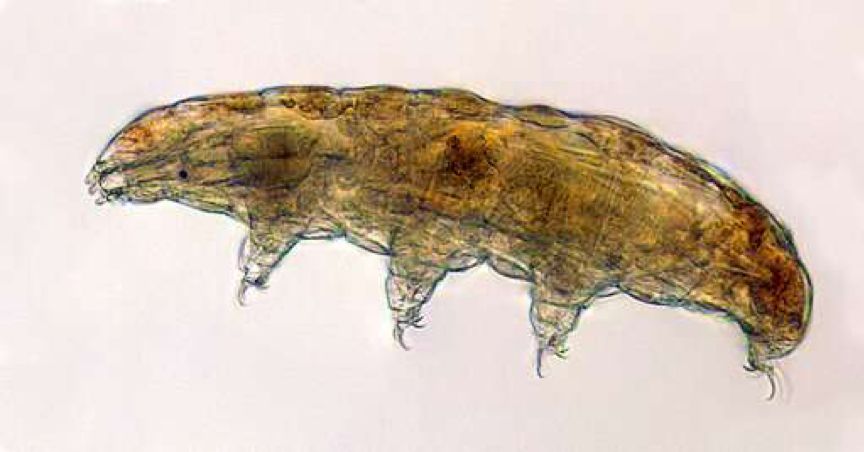
This undated microscope photo provided by Thomas Boothby in March 2019 shows a tardigrade, also known as a "water bear." The small animals, about the size of a period, are able to survive extreme heat, cold, radiation and even the vacuum of space. (Thomas Boothby via AP)
这张由托马斯·布斯比于2019年3月提供的日期未定的显微镜照片显示了一种缓步动物,也被称为“水熊”。 这种小动物体型极小,能够在极热、极冷、辐射甚至真空中生存。 (美联社托马斯·布斯比)
In December, the Defense Department's long-term research arm gave Boothby a nearly $5 million grant to figure out what in tardigrade genes might help human health.
去年12月,美国国防部的长期研究机构给布斯比提供了近500万美元的资助,用于研究缓步动物基因中可能有助于人类健康的成分。
The idea is to see if the tricks that tardigrades use to protect themselves when they dry can be used to protect vaccines and human blood, Boothby said.
布斯比说,这个想法是想看看缓步动物在缺水时用来保护自己的技巧是否可以用来保护疫苗和人类血液。
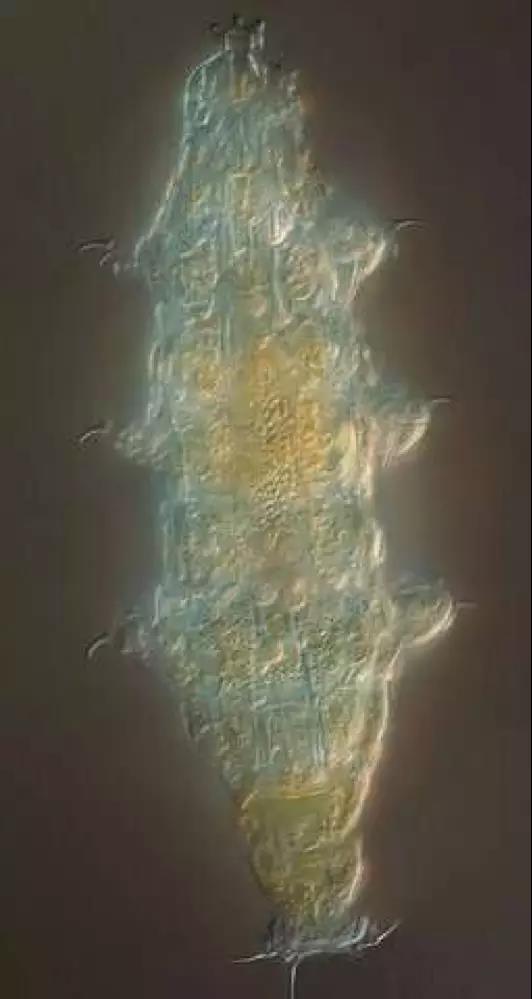
This undated microscope photo provided by Thomas Boothby in March 2019 shows a tardigrade, also known as a "water bear." The small animals, about the size of a period, are able to survive extreme heat, cold, radiation and even the vacuum of space. (Thomas Boothby via AP)
这张由托马斯·布斯比于2019年3月提供的日期未定的显微镜照片显示了一种缓步动物,也被称为“水熊”。 这种小动物体型极小,能够在极热、极冷、辐射甚至真空中生存。 (美联社托马斯·布斯比)
Boothby hopes to make bags of blood last longer than the current six weeks and allow them to be stored in a dried state so soldiers can take their own blood supply to battle or ambulances can carry more. Tardigrade tricks could possibly also help with preserving vaccines to help reduce the enormous cost and complexity of trying to keep vaccines cold. They could also potentially help preserve organs or damaged tissue.
布斯比希望使血袋的保存时间超过目前的六周,并将血袋保存在干燥的状态,这样士兵们就可以自己携带血液去战场,或者救护车可以运送更多的血液。 缓步动物的技巧也可能有助于保存疫苗,以帮助降低保存疫苗的巨大成本和复杂性。它们还可能有助于保存器官或受损组织。
Japanese scientists are studying whether tardigrade proteins could help them come up with a better sunscreen to protect against ultraviolet rays that cause skin cancer. A 2016 study showed that human cells augmented with a DNA protein unique to tardigrades reduced radiation damage in preliminary lab tests.
日本科学家正在研究缓步动物的蛋白质是否能帮助他们研制出一种更好的防晒霜,以抵御导致皮肤癌的紫外线。2016年的一项研究表明,在初步的实验室测试中,人体细胞中增加了缓步动物特有的DNA蛋白,可以减少辐射损伤。
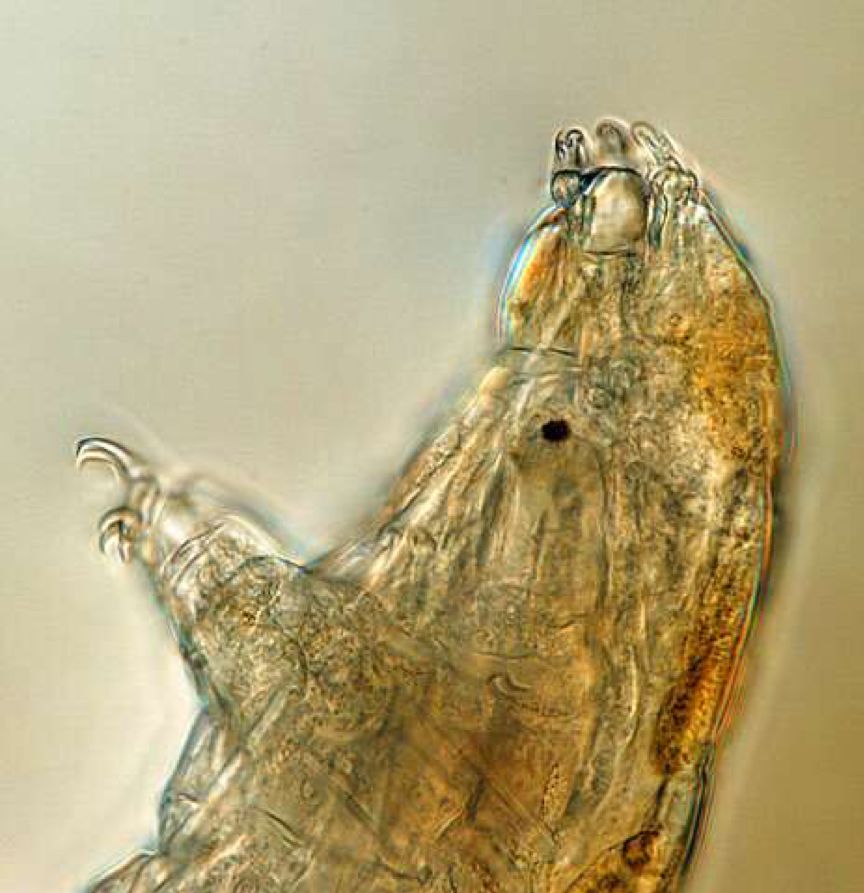
This undated microscope photo provided by Thomas Boothby in March 2019 shows a tardigrade, also known as a "water bear." The small animals, about the size of a period, are able to survive extreme heat, cold, radiation and even the vacuum of space. (Thomas Boothby via AP)
这张由托马斯·布斯比于2019年3月提供的日期未定的显微镜照片显示了一种缓步动物,也被称为“水熊”。 这种小动物体型极小,能够在极热、极冷、辐射甚至真空中生存。 (美联社托马斯·布斯比)
Tardigrades are so otherworldly that some theorize that they could easily exist on planets outside the solar system. Harvard astronomer Avi Loeb said "they could survive an impact by a rock and they could potentially be brought from another planet to Earth. ”
缓步动物是如此的超凡脱俗,以至于一些理论认为它们可以很容易地存在于太阳系之外的行星上。哈佛大学的天文学家阿维·勒布表示,“它们可以在撞击下幸存下来,还可能被从另一个星球带到地球上。”
Loeb and colleagues decided to see if life on Earth could survive some of the worst cosmic calamities. So they looked look at the hearty tardigrades, concluding that the water bears could survive most end-of-the-world scenarios, like a giant asteroid crash, cosmic ray burst or nearby supernova.
勒布和他的同事们决定看看地球上的生命是否可以在一些最严重的宇宙灾难中幸存下来。因此,他们观察了这些精力充沛的缓步动物,得出结论:水熊可以在世界末日的大多数情况下生存下来,比如巨大的小行星撞击、宇宙射线爆发或附近的超新星。
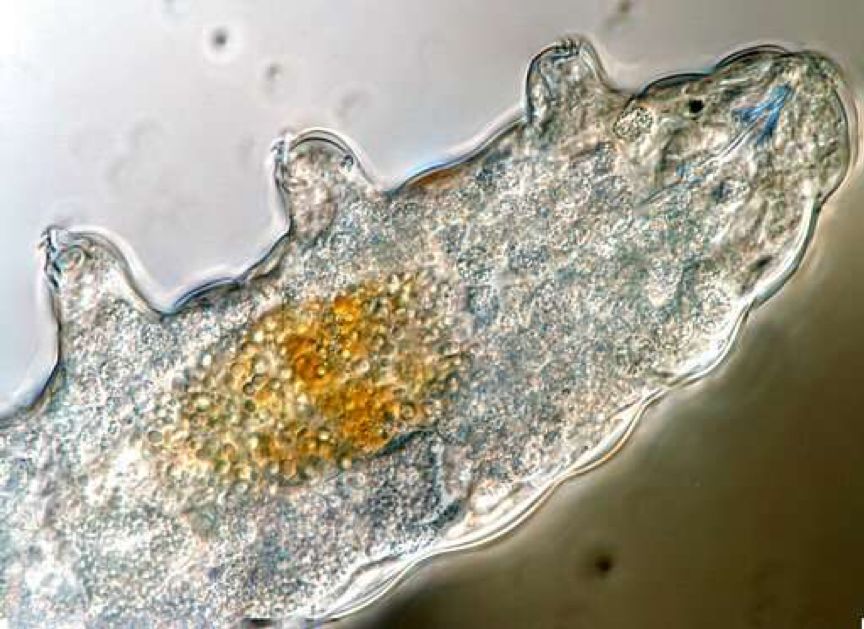
This undated microscope photo provided by Thomas Boothby in March 2019 shows a tardigrade, also known as a "water bear." The small animals, about the size of a period, are able to survive extreme heat, cold, radiation and even the vacuum of space. (Thomas Boothby via AP)
这张由托马斯·布斯比于2019年3月提供的日期未定的显微镜照片显示了一种缓步动物,也被称为“水熊”。 这种小动物体型极小,能够在极热、极冷、辐射甚至真空中生存。 (美联社托马斯·布斯比)
"It's good to know that at least one creature on Earth has a chance of surviving no matter what," Loeb said.
“很高兴知道地球上至少有一种生物无论如何都有生存的机会,”勒布说。

